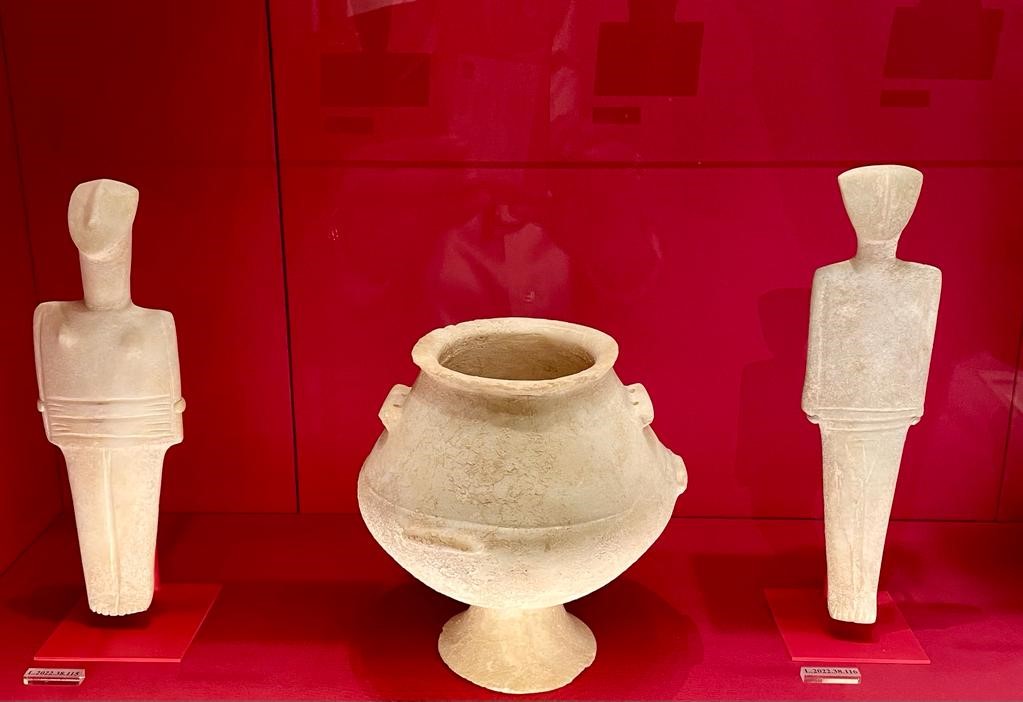The Cyclades in New York City


As the museumgoer goes up the steps from 5th Avenue, he goes through the building’s entrance, turns left and faces the Stern Collection, which includes 161 Cycladic antiquities, open to the public as of Thursday at the Metropolitan Museum of Art (Met). It appears impressive, and its title, “Cycladic Art: The Leonard N. Stern Collection on Loan from the Hellenic Republic” seems to attempt to use the word “loan” to explain how things stand.
As is known, the origin of the 161 antiquities and the way in which they came under Greek ownership had been an issue that caused certain reactions. The deal agreed to by the Culture Ministry, the Met, the Museum of Cycladic Art and the newly-founded, Delaware-based Hellenic Ancient Culture Institute, which was ratified by the Greek Parliament in September 2022, was certainly unprecedented. This is the characteristic that the Met’s director, Max Hollein, emphasizes to Kathimerini, and he notes that it’s not just a “historic cooperation” and a “long-term loan,” but also an “innovative solution and arrangement.” As Hollein also says, “this is both the first exhibition of the Stern Collection in its entirety – the most complete private collection of Cycladic art formed outside of Greece and is based here in New York – and also the largest single repatriation of antiquities to Greece to date.”
Starting in November 2022, 15 of the collection’s figurines and vases were exhibited at the Museum of Cycladic Art for one year. It was the first phase of the agreement’s implementation between the Culture Ministry, the Met, and the Athens-based museum, and the collection will remain in the American institution as a loan for 25 years (plus another 25 if the Greek state agrees to it). Regarding the exhibition that opened Thursday, the antiquities will be exhibited for a decade in a room adorned by the insignia of the Hellenic Republic and will then gradually return to Greece. This cooperation “contributes to the global promotion of Cycladic culture,” says the president of the Cycladic Art Museum, Kassandra Marinopoulou.


“The 25 additional loan years should not be taken for granted,” Culture Minister Lina Mendoni tells Kathimerini. “The Culture Ministry,” she explains, “might not be in agreement.” In any case, she adds, a 50-year-long international showcase of Cycladic culture has been agreed to with the American institution. A memorandum of cooperation has also been signed, which, among other things, entails the organization of a symposium on finding out the origins of the antiquities – discussions with the Met are underway. The minister adds that this coming September will see an announcement for the “Cycladic Art Residencies Program,” which will be addressed to archeologists, while the establishment of the “Study Center of Cycladic Culture,” as part of the Museum of Cycladic Culture in Naxos, was also recently announced. The latter, Mendoni says, will also be the Stern Collection’s final destination.
Speaking of repatriations, it should be noted that last summer, the Manhattan district attorney’s office seized about 70 antiquities from the home of Shelby White, a collector and emeritus member of the Met’s board of directors. The American museum had already announced its intention of thoroughly investigating the matter and finding out where the objects in its collection had come from. As Max Hollein says to Kathimerini, these actions would include hiring “additional staff members tasked with discovering the origins of the objects, investigating projects connected to specific dealers and collectors, as well as organizing conferences on matters of cultural heritage.”
“We’re in the process of finalizing the appointment of a chief of investigations on the origins of the objects in our collection, as well as three additional investigators,” the director adds. Moreover, a recent reappraisal of the museum’s collections led to the return of objects to Nepal, Yemen, Cambodia and Thailand. “Furthermore, we continue to collaborate with colleagues and institutions around the world,” Hollein concludes, “and we’re forging important partnerships, just as the agreement between the Met, the Greek Culture Ministry, and the Museum of Cycladic Art, which constitutes an exciting and forward-looking approach, and a unique model of cooperative repatriation.”
Source: ekathimerini.com











